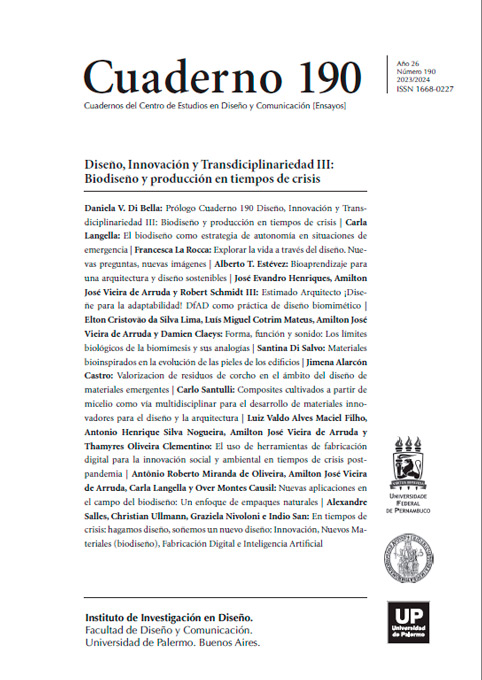Bio-inspired materials in the evolution of the building skins
Résumé
We are currently addressing a significant problem all over the world which is the energy shortage combined with the issue of the high energy consumption of buildings.
Références
Best, R. C. (1982). Thermoregulation in resting and active polar bears. Journal of comparative physiology, 146(1), 63-73.
Conzatti, A. (2020), The Biological Metaphor: Skin-façade analogy and biomimetic architecture. In The City and the Skin; Lulu: Morrisville, NC, USA.
Del Grosso, A. E., & Basso, P. (2010). Adaptive building skin structures. Smart Materials and Structures, 19(12), 124011.Di Salvo, 2018 Kinetic
Di Salvo, S. (2020). Façade Solar Control and Shading Strategies for Buildings in the Mediterranean Region. In International Journal of Environmental Science & Sustainable Development, 5(2), 32-47.
Dörfler, K., Hack, N., Sandy, T., Giftthaler, M., Lussi, M., Walzer, A. N., & Kohler, M. (2019). Mobile robotic fabrication beyond factory conditions: Case study Mesh Mould wall of the DFAB HOUSE. Construction robotics, 3, 53-67.
Faragalla, A. M. A., & Asadi, S. (2022). Biomimetic Design for Adaptive Building Façades: A Paradigm Shift towards Environmentally Conscious Architecture. Energies, 15(15), 5390.
Fricke, J. & Reichenauer, Gudrun. (2011). Thermal. Acoustical and Structural Properties of Silica Aerogels. MRS Proceedings. 73. 10.1557/PROC-73-775.
Geddes, G. (2016 August 5) Reinventing the building envelope. https://www.aechive.net/aec-business-podcast/reinventing-the-building-envelope-interview-with-gordon-a-geddes.
Ihara, Takeshi & Gao, Tao & Grynning, Steinar & Jelle, Bjørn & Gustavsen, Arild. (2015). Aerogel granulate glazing façades and their application potential from an energy saving perspective. Applied Energy. 142. 10.1016/j.apenergy.2014.12.053.
Krieg, O. D. (2016). HygroSkin–meteorosensitive pavilion. In Advancing Wood Architecture (pp. 125-140). Routledge.
Landa, M. (2017). Shigeru Ban: Exploring the limits of creativity. Materia Arquitectura, (15), 22-29.
Liddell, I. (2015). Frei Otto and the development of gridshells. Case Studies in Structural Engineering, 4, 39-49.
Lynch, P. (2016). Thoughts about the Work of Obra Architects. In OBRA Architects Logic : Selected Projects 2006-2016 (pp. 11–27).
Melis, A. & Medas, B. (2020) Tecnologie avanzate per la resilienza dell’architettura e della comunità. In: Bioarchitettura: Appunti per una città sostenibile. Nardini Editore.
MIT (2023 January). Riddle solved: Why was Roman concrete so durable? https://news.mit.edu/2023/roman-concrete-durability-lime-casts-0106.
MIT, Civil and Environmental Engineering, (2022 November 3). Admir Masic. https://cee.mit.edu/people_individual/admir-masic/
Paneri, A., Wong, I. L., & Burek, S. (2019). Transparent insulation materials: An overview on past, present and future developments. Solar Energy, 184, 59-83.
Ramírez, J. D., & Guzmán, J. A. (2017). How can concrete be improved through processes that are bio-friendly to the environment and that enhance its construction qualities?. Tekhnê, 14(2), 49-58.
Sala, N. & Cappellato, G. (2004). Architetture della complessità: la geometria frattale tra arte architettura e territorio, F. Angeli, Milano.
Sarkis, H. (2021). How will we live together?. Statement. 17ª Biennale Architettura.
Siani, R. (2012), Il processo biomimetico sistemico nel progetto tecnologico di architettura. strumenti metodologici, informatici e meccanici, Tesi Università degli Studi di Napoli Federico II, Dipartimento di Architettura Dottorato di Ricerca in Tecnologia dell’architettura e Rilievo e Rappresentazione dell’Architettura e dell’Ambiente, XXVII Ciclo.
Seifan, M., Samani, A. K., & Berenjian, A. (2016). Bioconcrete: next generation of self-healing concrete. Applied microbiology and biotechnology, 100, 2591-2602.
Stehling, H., Scheurer, F., Roulier, J., Geglo, H., & Hofmann, M. A. T. H. I. A. S. (2017). From lamination to assembly-modelling the Seine Musicale. Fabricate: Rethinking Design and Construction, 3, 258-263.
Sung, D. (2016) Smart Geometries for Smart Materials: Taming Thermobimetals to Behave, Journal of Architectural Education, 70:1, 96-106.
Usai, S., & Stehling, H. (2018). La seine musicale. In Humanizing Digital Reality (pp. 201- 209). Springer, Singapore.
Vezzoli, C. & Manzini, E. (2008). Design for environmental sustainability (p. 4). London: Springer.
Wang, Y., Cui, Y., Shao, Z., Gao, W., Fan, W., Liu, T., & Bai, H. (2020). Multifunctional polyimide aerogel textile inspired by polar bear hair for thermoregulation in extreme environments. Chemical Engineering Journal, 390, 124623.
World Health Organization (2018). Climate change and health. [Online]. 1 February 2018. Key facts. Available from: https://www.who.int/news-room/fact-sheets/detail/climate-change-and-health [Accessed:22/December 2022].
Zakeri, B., Paulavets, K., Barreto-Gomez, L., Echeverri, L. G., Pachauri, S., Boza-Kiss, B. & Pouya, S. (2022). Pandemic, War, and Global Energy Transitions. Energies, 15(17), 6114.
Zhang, Y., He, C. Q., Tang, B. J., & Wei, Y. M. (2015). China’s energy consumption in the building sector: A life cycle approach. Energy and Buildings, 94, 240-251.
Los autores/as que publiquen en esta revista ceden los derechos de autor y de publicación a "Cuadernos del Centro de Estudios de Diseño y Comunicación", Aceptando el registro de su trabajo bajo una licencia de atribución de Creative Commons, que permite a terceros utilizar lo publicado siempre que de el crédito pertinente a los autores y a esta revista.


